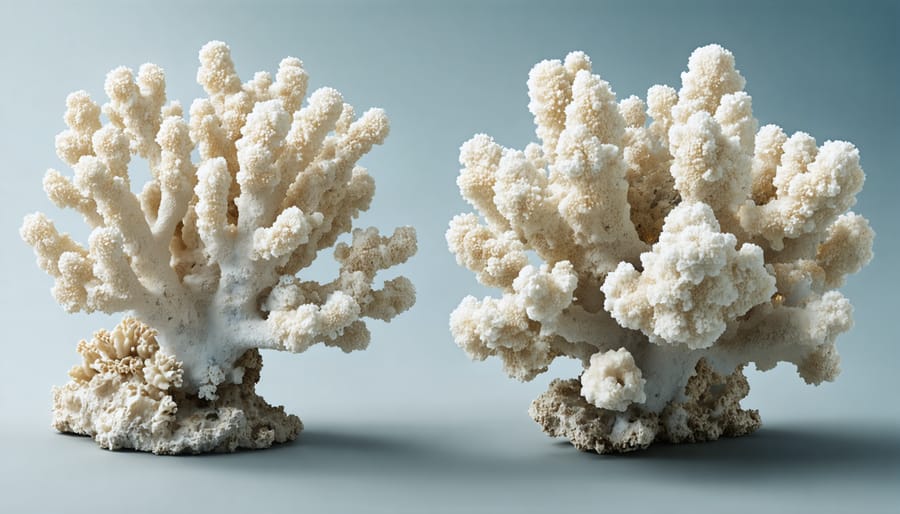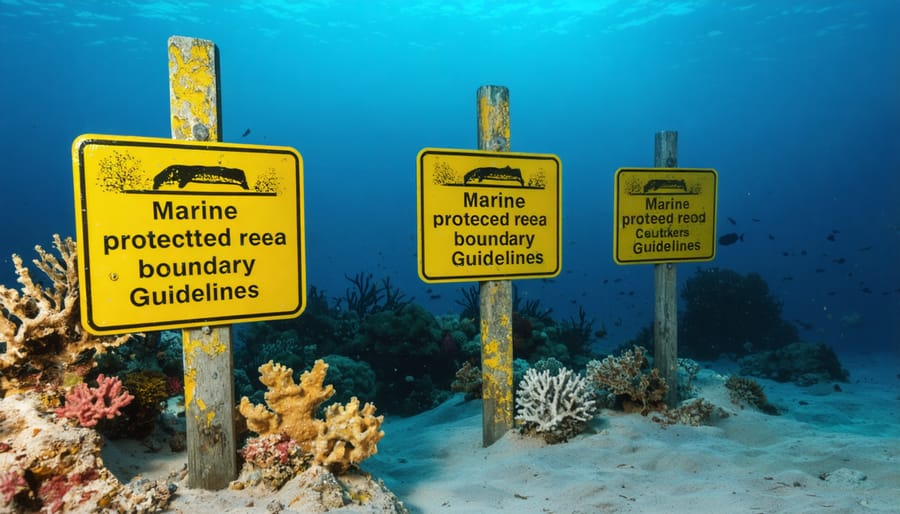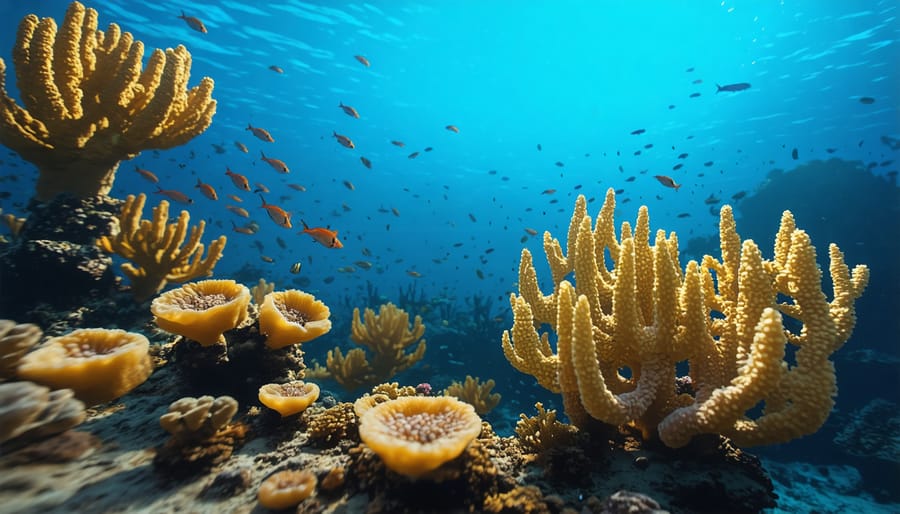
The world’s oceans are experiencing unprecedented changes that threaten marine ecosystem biodiversity at an alarming rate. Rising sea temperatures, ocean acidification, and shifting currents are transforming marine environments faster than at any point in recorded history. From the deteriorating Great Barrier Reef to the rapidly warming Arctic waters, these changes are not just statistics – they represent a fundamental reshaping of Earth’s most vital ecosystems.
Recent scientific evidence reveals that marine environments are absorbing more than 90% of the excess heat trapped by greenhouse gases, acting as our planet’s primary climate regulator. This massive heat absorption comes at a devastating cost: coral bleaching events are becoming more frequent, marine species are forced to migrate to cooler waters, and entire food webs are being disrupted. For coastal communities worldwide, these changes translate into immediate threats to food security, economic stability, and cultural heritage.
Yet, amid these challenges, innovative solutions and collaborative international efforts offer hope. Scientists, policymakers, and communities are working together to develop resilient marine protected areas, implement sustainable fishing practices, and reduce carbon emissions. Understanding these changes – and our role in addressing them – has never been more crucial for the future of our blue planet.
The Rising Tide of Climate Change Impacts
Ocean Acidification and Temperature Changes
The world’s oceans are experiencing unprecedented changes in their chemical composition and temperature, creating a domino effect that impacts marine life at every level. As atmospheric carbon dioxide levels rise, approximately 30% of these emissions are absorbed by our oceans, leading to increased acidity in marine waters. This process, known as ocean acidification, makes it difficult for shell-forming organisms like corals, mollusks, and certain plankton species to build and maintain their calcium carbonate structures.
Ocean temperatures have risen by an average of 0.13°C per decade since 1901, with the rate of warming accelerating in recent years. This warming creates a hostile environment for temperature-sensitive species and disrupts essential oceanic circulation patterns. Marine biologist Dr. Sarah Chen notes, “We’re seeing coral bleaching events becoming more frequent and intense, forcing many species to migrate toward cooler waters or face local extinction.”
The combined effects of acidification and warming create what scientists call a “deadly duo.” These changes affect everything from phytoplankton productivity to fish reproduction rates. In tropical regions, where many species already live close to their thermal limits, even slight temperature increases can have devastating consequences.
However, research shows that reducing carbon emissions can slow these changes. Local initiatives to protect and restore marine habitats, particularly seagrass meadows and mangrove forests, help buffer against acidification and provide refuge for affected species.

Ecosystem Disruption and Species Migration
Climate change is triggering unprecedented shifts in marine ecosystems, causing species to migrate beyond their traditional ranges in search of more suitable conditions. As ocean temperatures rise, many marine species are moving toward cooler waters, typically heading poleward or into deeper depths. This mass migration is reshaping marine communities and disrupting established food webs.
Marine biologist Dr. Sarah Chen observes, “We’re witnessing what we call ‘marine refugee species’ – organisms forced to abandon their native habitats due to changing environmental conditions. This displacement has far-reaching consequences for both the ecosystems they leave behind and the ones they enter.”
Tropical species are increasingly appearing in temperate waters, while cold-water species retreat further north or south. For example, tropical parrotfish are now regularly spotted in Mediterranean waters, while Atlantic cod populations have shifted northward into the Arctic. These changes affect not only the migrating species but also the entire ecological network, including predator-prey relationships and breeding patterns.
Coral reef ecosystems are particularly vulnerable to these disruptions. As water temperatures rise, many reef-dependent species must either adapt or relocate. This movement creates new challenges for marine protected areas, which were established based on historical species distributions that may no longer be relevant.
Conservation efforts now focus on creating adaptive management strategies that account for these shifting distributions, including the establishment of mobile marine protected areas and wildlife corridors that allow for species movement across different temperature zones.
Building Climate-Resilient Management Strategies
Protected Area Design and Implementation
Protected areas are evolving to meet the challenges of climate change, with innovative design strategies that prioritize resilience and adaptability. Marine protected areas (MPAs) now incorporate climate-smart principles, including the establishment of corridors that allow species to migrate as water temperatures change and the protection of diverse habitat types that serve as climate refugia.
Key elements of climate-smart MPA design include selecting sites with naturally variable conditions, as these areas often harbor species more adaptable to change. Designers also prioritize protecting deep-water habitats, which typically experience less temperature fluctuation and can serve as sanctuaries for temperature-sensitive species.
Implementation strategies focus on creating networks of protected areas rather than isolated reserves. These networks provide stepping stones for species movement and enhance genetic connectivity between populations. Managers are also adopting dynamic boundaries that can shift with changing species distributions and ocean conditions.
Community engagement plays a crucial role in successful implementation. Local stakeholders, including fishing communities and indigenous peoples, are increasingly involved in both design and management decisions. This participatory approach ensures better compliance with protection measures and helps integrate traditional ecological knowledge into adaptive management strategies.
Monitoring programs within these areas use advanced technologies like remote sensing and environmental DNA analysis to track ecosystem changes and assess the effectiveness of protection measures. This data-driven approach allows managers to adjust strategies as needed, creating more resilient protected areas capable of withstanding climate impacts.

Sustainable Fisheries Management
As climate change continues to impact marine ecosystems, the development of adaptive sustainable fishing practices has become crucial for protecting ocean resources. Modern fisheries management combines scientific data with traditional knowledge to create flexible quota systems that respond to changing ocean conditions.
These adaptive management strategies use real-time monitoring of fish populations, ocean temperatures, and ecosystem health to adjust fishing quotas throughout the season. This dynamic approach helps prevent overfishing while supporting fishing communities that depend on marine resources for their livelihoods.
Marine protected areas (MPAs) play a vital role in this management system, serving as refuges where fish populations can rebuild and adapt to changing conditions. These protected zones work in conjunction with carefully managed fishing areas to create a balanced approach to conservation and resource use.
Innovative technologies, such as satellite tracking and AI-powered monitoring systems, help enforce fishing regulations and collect data on fish migration patterns affected by climate change. This information allows fisheries managers to make informed decisions about catch limits and seasonal restrictions.
Success stories from regions implementing these adaptive management strategies show promising results. For example, several North Atlantic fisheries have maintained stable fish populations despite warming waters by adjusting their quotas based on climate impact assessments and regular stock surveys.
Ecosystem-Based Adaptation
Ecosystem-based adaptation (EbA) represents a powerful natural approach to addressing marine climate change impacts. By working with nature rather than against it, coastal communities can enhance their resilience while protecting marine biodiversity. These strategies leverage existing ecosystems’ natural ability to buffer against climate impacts and support vital ocean sustainability initiatives.
Mangrove restoration projects exemplify successful EbA implementation, providing multiple benefits including storm surge protection, carbon sequestration, and habitat creation for marine species. Similarly, coral reef rehabilitation efforts help maintain these crucial ecosystems that shield coastlines while supporting thousands of marine species.
Seagrass meadow conservation and restoration has gained momentum as an effective EbA strategy. These underwater grasslands not only capture carbon at rates far exceeding terrestrial forests but also provide essential nursery grounds for commercial fish species and help prevent coastal erosion.
Living shorelines, which incorporate natural elements like oyster reefs and salt marshes, offer sustainable alternatives to traditional hard infrastructure. These solutions adapt to changing conditions while providing essential ecosystem services and habitat connectivity.
Community involvement plays a crucial role in EbA success. Local fishing communities, indigenous peoples, and coastal residents often contribute traditional ecological knowledge and participate in restoration efforts, ensuring long-term project sustainability and effectiveness.
Success Stories from the Field
The Great Barrier Reef Resilience Project
The Great Barrier Reef Resilience Project stands as a pioneering example of how climate resilience strategies can be implemented on a massive scale. Launched in 2017, this collaborative initiative brings together marine scientists, local communities, and indigenous groups to protect and restore the world’s largest coral reef system.
The project employs a multi-faceted approach, combining cutting-edge technology with traditional knowledge. Using thermal imaging drones and AI-powered coral monitoring systems, researchers identify heat-resistant coral colonies that show promise for reef restoration. These “super corals” are then carefully propagated in specialized nurseries before being transplanted to degraded areas.
Dr. Sarah Chen, lead marine biologist for the project, reports encouraging results: “We’ve seen a 40% increase in coral coverage in our pilot sites, with particularly strong survival rates among heat-adapted species.” The project also engages local communities through its “Reef Guardians” program, where volunteers assist in coral monitoring and maintenance activities.
One innovative aspect is the implementation of “cooling stations” – strategic positions where cold-water upwelling is enhanced to provide thermal refuge during bleaching events. Combined with reduced local stressors and enhanced water quality management, these interventions are helping the reef adapt to changing conditions while building community stewardship.
The project’s success has inspired similar initiatives worldwide, demonstrating how collaborative adaptive management can enhance marine ecosystem resilience in the face of climate change.

Community-Led Conservation Initiatives
Around the world, coastal communities are taking the lead in protecting their marine ecosystems from climate change impacts through innovative grassroots initiatives. In the Philippines, local fishing communities have established marine protected areas (MPAs) managed by volunteer reef rangers who monitor coral health and enforce no-take zones. These community-led MPAs have shown remarkable success, with some areas reporting up to 30% increase in fish populations within just five years.
In the Caribbean, indigenous communities have revived traditional fishing practices while incorporating modern conservation techniques. Through the “Fish Smart” program, fishers use data collection apps to track species populations and adjust their harvesting patterns accordingly, ensuring sustainable yields for future generations.
Along Australia’s Great Barrier Reef, citizen science projects enable local residents to participate in coral restoration efforts. Volunteers assist marine biologists in coral gardening, where fragments of healthy coral are cultivated and transplanted to degraded areas. This initiative has successfully restored several reef sections while building community awareness and engagement.
In the Pacific Northwest, tribal nations lead kelp forest restoration projects, combining ancestral knowledge with contemporary science. These projects not only protect crucial marine habitats but also create carbon sinks that help mitigate climate change impacts.
These community-driven approaches demonstrate how local action can create significant positive change, inspiring similar initiatives worldwide and proving that effective marine conservation starts at the grassroots level.
Taking Action: How You Can Help
Taking meaningful action to protect our marine ecosystems is within everyone’s reach. Whether you’re a student, professional, or concerned citizen, there are numerous ways to contribute to marine conservation efforts and combat climate change impacts on our oceans.
Start by reducing your carbon footprint through simple daily choices. Choose sustainable seafood options by consulting guides like the Marine Stewardship Council’s recommendations. Minimize single-use plastics, which often end up in our oceans, by carrying reusable water bottles, shopping bags, and food containers.
Join local beach cleanup initiatives or organize your own. These events not only remove harmful debris but also provide valuable data for marine research programs. Many coastal communities have established volunteer networks that coordinate regular cleanup activities and citizen science projects.
Support marine protected areas by becoming a volunteer monitor or educator. Organizations like reef conservation groups and marine sanctuaries often seek passionate individuals to assist with coral monitoring, sea turtle protection, and public education programs.
Consider supporting marine research through citizen science platforms. Applications and websites allow you to contribute to real scientific research by reporting marine wildlife sightings, documenting coastal changes, or monitoring local water quality.
Make your voice heard by advocating for marine protection policies. Write to your local representatives about supporting climate-resilient marine conservation initiatives. Share accurate information about marine climate change with your community through social media and local events.
For those able to make financial contributions, donate to reputable marine conservation organizations that work directly on climate resilience projects. Even small monthly donations can support crucial research and conservation efforts that protect our marine ecosystems for future generations.
The profound impacts of marine climate change demand our immediate attention and concerted action. Throughout this article, we’ve explored how rising ocean temperatures, acidification, and changing currents are fundamentally altering marine ecosystems worldwide. These changes affect not just marine life, but also human communities that depend on healthy oceans for food security, economic stability, and cultural identity.
While the challenges are significant, there are reasons for hope. Scientific research continues to advance our understanding of marine ecosystems’ resilience and adaptation potential. Conservation efforts, from establishing marine protected areas to reducing plastic pollution, are showing positive results in many regions. Community-led initiatives and international cooperation demonstrate our collective capability to address these challenges.
The time for action is now. Whether through supporting marine conservation organizations, making sustainable seafood choices, or participating in coastal cleanup efforts, each of us can contribute to protecting our oceans. By combining scientific knowledge with practical conservation measures and public engagement, we can work toward a future where marine ecosystems thrive despite climate challenges. Our oceans’ health is intrinsically linked to our own survival, making their protection not just an environmental imperative but a human one.
jessica
Ava Singh is an environmental writer and marine sustainability advocate with a deep commitment to protecting the world's oceans and coastal communities. With a background in environmental policy and a passion for storytelling, Ava brings complex topics to life through clear, engaging content that educates and empowers readers. At the Marine Biodiversity & Sustainability Learning Center, Ava focuses on sharing impactful stories about community engagement, policy innovations, and conservation strategies. Her writing bridges the gap between science and the public, encouraging people to take part in preserving marine biodiversity. When she’s not writing, Ava collaborates with local initiatives to promote eco-conscious living and sustainable development, ensuring her work makes a difference both on the page and in the real world.
